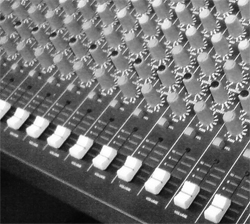These gold nuggets of mixing/audio production wisdom are insights into doing something small to make a huge impact. My notebook is filled with audio mixing tips and tricks from the Gurus of Tech 2013 conference earlier this year.
That tells you two things; the conference was great, and I still go old school with a paper notebook. If I wasn’t writing down something I thought was useful, I was writing down something I thought you’d find useful.
1. Consider building your mix off of a template.
—Consider all of the instruments and singers in the worship band. Consider a template of presets with the following in mind;
—Engage the HPF (high-pass filter) for channels which usually benefit from a HPF.
—What channels would likely benefit from compression? Set their threshold but don’t engage it yet.
—Start all faders at unity.
—Consider where the vocalist sits in the mix – are they more high, mid, or low-range singers? Now you know where to carve out space for them in the other channels.
This template concept is a great way to build a mix from scratch. You could add to the above points if you think about it.
2. Use compression for producing a well-rounded sound.
Having multiple channels with a wide-range of volume dynamics makes it difficult to produce a well-rounded sound. Use compression to even out many of those volume spikes.
3. Hear what your live microphones hear.
Listen via PFL/SOLO to a vocal microphone and pay attention to all of the other sounds the microphone is picking up. This gives you an idea of other stuff your microphone is picking up and why microphone proximity to the sound source is so important.
4. Know what you COULD be boosting.
Microphones on the stage can pick up a variety of background sounds. In particular, boosting the high-end frequencies of a vocal microphone can pick up drum cymbals and unintentionally accentuate them.
5. Pull your male singers out of the mud.
Cut your male vocals in the 325-350 Hz range to clear up your vocals. Often, the 325-350 Hz range is where the muddiness exists.
6. Use reverb for vocal separation.
Using a lot reverb, you can push a singer into the background. Using a little, you can make it stand out in the mix. Use your ears to find out what’s best for your situation.
7. The kick drum and bass can work together on your low end sound.
Try letting the bass give you the tone of the low-end while letting the kick drum win on the attack.





















